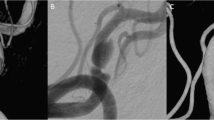Abstract
Background and Purpose
The experience of flow diverters (FDs) in treating large vertebral artery-dissecting aneurysms (VADAs) is still limited. This study was conducted to present our long-term outcome of VADAs treated with a Tubridge flow diverter (TFD), a new device developed in China.
Materials and Methods
The clinical and angiographic data of six patients harboring large VADAs and treated with TFDs were prospectively collected and analyzed.
Results
A total of nine TFDs were successfully implanted in six patients. Angiographic follow-up images were available for all patients at a median of 26.0 (18.5, 37.5) months after treatment. Five of the six VADAs were completely occluded, and the last was improved (near complete occlusion). In-stent stenosis was detected in one case and was handled appropriately by angioplasty and stenting. All covered branches and parent arteries remained patent. There were no complications or new neurological deficits observed in any of the patients. At the latest clinical follow-up (36.5 (26.0, 44.5) months), all patients achieved 0 in the modified Rankin scale score.
Conclusions
Our preliminary experience suggests that the Tubridge flow diverter might be an alternative treatment for large and recurrent dissecting aneurysms derived from the vertebral artery.


Similar content being viewed by others
References
Mizutani T, Aruga T, Kirino T, Miki Y, Saito I, Tsuchida T. Recurrent subarachnoid hemorrhage from untreated ruptured vertebrobasilar dissecting aneurysms. Neurosurgery. 1995;36(5):905–11; discussion 912–3.
Yoshimoto Y, Wakai S. Unruptured intracranial vertebral artery dissection. Clinical course and serial radiographic imagings. Stroke. 1997;28(2):370–4.
Fukasawa I, Sasaki H, Nukui H. Surgical treatment for ruptured vertebral artery dissecting aneurysms. Neurol Med Chir (Tokyo). 1998;38(Suppl):104–6.
Iihara K, Sakai N, Murao K, Sakai H, Higashi T, Kogure S, Takahashi JC, Nagata I. Dissecting aneurysms of the vertebral artery: a management strategy. J Neurosurg. 2002;97(2):259–67.
Albuquerque FC, Park MS, Abla AA, Crowley RW, Ducruet AF, McDougall CG. A reappraisal of the Pipeline embolization device for the treatment of posterior circulation aneurysms. J Neurointerv Surg. 2015;7(9):641–5.
Murthy SB, Shah S, Shastri A, Venkatasubba RC, Bershad EM, Suarez JI. The SILK flow diverter in the treatment of intracranial aneurysms. J Clin Neurosci. 2014;21(2):203–6.
Monteith SJ, Tsimpas A, Dumont AS, Tjoumakaris S, Gonzalez LF, Rosenwasser RH, Jabbour P. Endovascular treatment of fusiform cerebral aneurysms with the Pipeline Embolization Device. J Neurosurg. 2014;120(4):945–54.
Zhou Y, Yang PF, Fang YB, Xu Y, Hong B, Zhao WY, Li Q, Zhao R, Huang QH, Liu JM. A novel flow-diverting device (Tubridge) for the treatment of 28 large or giant intracranial aneurysms: a single-center experience. AJNR Am J Neuroradiol. 2014;35(12):2326–33.
O’Kelly CJ, Krings T, Fiorella D, Marotta TR. A novel grading scale for the angiographic assessment of intracranial aneurysms treated using flow diverting stents. Interv Neuroradiol. 2010;16(2):133–7.
Zhao KJ, Zhao R, Huang QH, Xu Y, Hong B, Fang YB, Li Q, Yang PF, Liu JM, Zhao WY. The interaction between stent(s) implantation, PICA involvement, and immediate occlusion degree affect symptomatic intracranial spontaneous vertebral artery dissection aneurysm (sis-VADA) recurrence after reconstructive treatment with stent(s)-assisted coiling. Eur Radiol. 2014;24(9):2088–96.
Ertl L, Holtmannspötter M, Patzig M, Brückmann H, Fesl G. Use of flow-diverting devices in fusiform vertebrobasilar giant aneurysms: a report on periprocedural course and long-term follow-up. AJNR Am J Neuroradiol. 2014;35(7):1346–52.
Brinjikji W, Murad MH, Lanzino G, Cloft HJ, Kallmes DF. Endovascular treatment of intracranial aneurysms with flow diverters: a meta-analysis. Stroke. 2013;44(2):442–7.
Zhao KJ, Fang YB, Huang QH, Xu Y, Hong B, Li Q, Liu JM, Zhao WY, Deng BQ. Reconstructive treatment of ruptured intracranial spontaneous vertebral artery dissection aneurysms: long-term results and predictors of unfavorable outcomes. PLoS One. 2013;8(6):e67169.
Song Y, Wang Y, Li C, Wang Y, Mu S, Yang X. Retreatment and outcomes of recurrent intracranial vertebral artery dissecting aneurysms after stent assisted coiling: a single center experience. PLoS One. 2014;9(11):e113027.
Darsaut TE, Rayner-Hartley E, Makoyeva A, Salazkin I, Berthelet F, Raymond J. Aneurysm rupture after endovascular flow diversion: the possible role of persistent flows through the transition zone associated with device deformation. Interv Neuroradiol. 2013;19(2):180–5.
Zhou Y, Yang PF, Fang YB, Xu Y, Hong B, Zhao WY, Li Q, Zhao R, Huang QH, Liu JM. Parent artery reconstruction for large or giant cerebral aneurysms using a Tubridge flow diverter (PARAT): study protocol for a multicenter, randomized, controlled clinical trial. BMC Neurol. 2014;14:97.
Kallmes DF, Hanel R, Lopes D, Boccardi E, Bonafe A, Cekirge S, Fiorella D, Jabbour P, Levy E, McDougall C, Siddiqui A, Szikora I, Woo H, Albuquerque F, Bozorgchami H, Dashti SR, Delgado Almandoz JE, Kelly ME, Turner R 4th, Woodward BK, Brinjikji W, Lanzino G, Lylyk P. International retrospective study of the pipeline embolization device: a multicenter aneurysm treatment study. AJNR Am J Neuroradiol. 2015;36(1):108–15.
Meckel S, McAuliffe W, Fiorella D, Taschner CA, Phatouros C, Phillips TJ, Vasak P, Schumacher M, Klisch J. Endovascular treatment of complex aneurysms at the vertebrobasilar junction with flow-diverting stents: initial experience. Neurosurgery. 2013;73(3):386–94.
Cohen JE, Gomori JM, Moscovici S, Leker RR, Itshayek E. Delayed complications after flow-diverter stenting: reactive in-stent stenosis and creeping stents. J Clin Neurosci. 2014;21(7):1116–22.
Acknowledgments
This work was supported by the National Sci-tech Support Plan grant number [2011BAI08B14] Shanghai Science and Technology Development Funds grant number [14441904702], National Natural Science Foundation of China grant number [81301004, 81471189] and Shanghai Science and Technology Development Funds grant number [13140903201].
Conflict of Interest
The other authors declared they have no competing interests.
Author information
Authors and Affiliations
Corresponding authors
Additional information
Yibin Fang and Wanling Wen are co-first authors.
Rights and permissions
About this article
Cite this article
Fang, YB., Wen, WL., Yang, PF. et al. Long-Term Outcome of Tubridge Flow Diverter(S) in Treating Large Vertebral Artery Dissecting Aneurysms—A Pilot Study. Clin Neuroradiol 27, 345–350 (2017). https://doi.org/10.1007/s00062-015-0494-8
Received:
Accepted:
Published:
Issue Date:
DOI: https://doi.org/10.1007/s00062-015-0494-8




